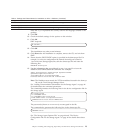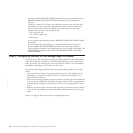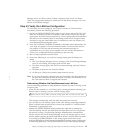
For a review of the results of the steps that you have just completed, see Figure 8
on page 27.
Disk Devices
Define paths on the server using the device names as seen by the storage agent on
each client system. For example, on the server side, the directory,
d:\tsmdata\server1, is exported on the NFS server running on the Tivoli Storage
Manager Server machine.
On the storage agent, the directory is NFS mounted as /tsmdata/server1. A path
needs to be created for each file drive in the library. The following is the command
issued to create the path for this scenario. In this example, disklib1 represents the
destination file drive in the disk library with a name of disklib.
define path storagnt disklib1 srctype=server desttype=drive library=disklib
device=file directory="/tsmdata/server1/fs1,/tsmdata/server1/fs2"
It is recommended that each directory correspond to a file system on a separate
physical drive. The server cannot validate PATH information that is provided on
the server for use by the storage agent. Failures can occur if incorrect device
information is provided in the DEFINE PATH command.
Note that if you specified multiple directories for the device class associated with
the FILE library, you must specify the same number of directories for each path to
the FILE library. To keep the device class and path synchronized, do not change or
move existing directories on the server that the storage agent is using. Adding
directories is permitted. Specifying a mismatched number of directories can cause a
run-time failure. See the ″Defining Device Classes″ chapter in the Administrator’s
Guide for more information.
For command information, see the Administrator’s Reference.
Step 4. (z/OS only) Formatting Volumes for LAN-free Data Movement
When using the z/OS data manager server, volumes for sequential access storage
pools that support LAN-free data movement require formatting before they can be
used. LAN-free sessions will fail if the storage pool does not contain any formatted
volumes and does not allow automatic formatting. For information about how to
format volumes, refer to the Administrator’s Guide.
Step 5. Starting the Storage Agent and Verifying the LAN-free
Configuration
In this final step, you start the storage agent and verify the LAN-free
configuration.
Step 5.1 Start the Storage Agent
After verifying that the server is online and running, start the storage agent by
changing to the storage agent directory and issuing the following command:
dsmsta
When the storage agent starts, it contacts all available shared libraries, including
those libraries that do not have a path defined. As a result, a delay may occur
during startup processing. The storage agent also determines if the Tivoli Storage
28 IBM Tivoli Storage Manager for SAN for AIX: Storage Agent User’s Guide
|
|
|
|
|
|
|
|


















